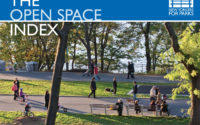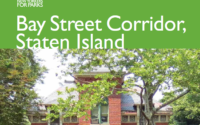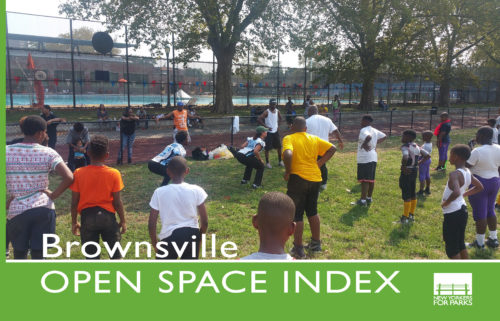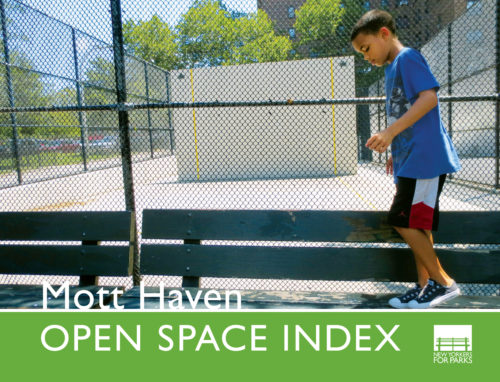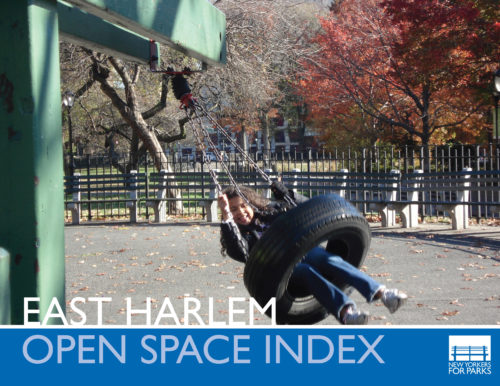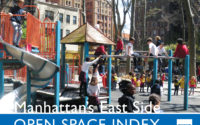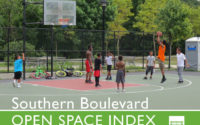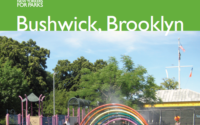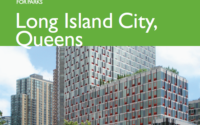In 2010, NY4P developed the Open Space Index (OSI) methodology, which is based on a set of 15 NYC-specific benchmarks against which we measure open space maintenance, access, variety and environmental sustainability, generating data on the study neighborhood’s strengths and needs.
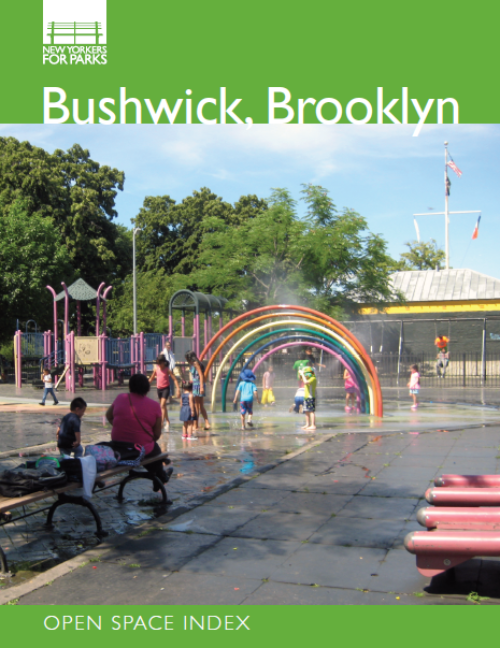
The Bay Street Corridor Open Space Index found that this neighborhood failed 11 of the 14 open space goals. The goals include total amount of open space, access, tree canopy, and overall maintenance. As one of the areas recently approved for a rezoning, residents and advocates are concerned about what impact increased density will have on their infrastructure and open spaces. Recommendations include bettering pedestrian access to new and existing open spaces and supporting community-derived plans like the Maritime Education and Recreational Corridor and the North Shore Greenway Heritage Trail.
The Bushwick Open Space Index found that the neighborhood failed 12 of the 14 open space goals. Goals include total amount of open space, access, tree canopy, and overall maintenance. As one of the areas currently in the rezoning process, residents and advocates are concerned about the changes increased density will create for the built environment and their existing open spaces. Recommendations include expanding access to open spaces through partnerships between the NYC Department of Parks and Recreation, the NYC Housing Authority, and the NYC Department of Education, and increasing multilingual wayfinding information and programming in existing open spaces.
The Long Island City Open Space Index found that the neighborhood failed 11 of the 14 open space goals. Goals include total amount of open space, access, tree canopy, and overall maintenance. The area was previously rezoned and was being considered for another rezoning, but is now proceeding with as-of-right rezoning on a case-by-case basis. Residents of this growing neighborhood are concerned about the disproportionate growth and their faltering infrastructure. Recommendations include honoring the investment commitments made in New York City’s LIC.NYC plan for local parks and open spaces, and expanding on existing plans for public space under the Queensboro Bridge such as the LIC Ramplands, El-Space, and others.
The Brownsville Open Space Index found that this neighborhood failed 10 of the 14 open space benchmarks. Benchmarks include total amount of open space, access, tree canopy and overall maintenance. Recommendations include increased programming in parks, especially for young people; increased NYPD engagement with community-based agencies and increasing youth access to open spaces; pair NYCHA infill development with improvements to NYCHA open spaces; increase funding for maintenance and programming, and more.
The Southern Boulevard Open Space Index found that the neighborhood failed eight of the 14 open space benchmarks, rising to 11 out of 14 when Crotona Park, which many residents have difficulty accessing, is excluded. Benchmarks include total amount of open space, access, tree canopy and overall maintenance. As one of the areas being studied for a possible rezoning, residents and advocates are also concerned about what impact increased density will have on their open spaces. Recommendations include supporting the community's visioning for the Bruckner Sheridan de-commissioning; expanding the Community Parks Initiative to capitally renew neglected pars; increased access to local waterfront parks; increased funding for maintenance, and more.
The Mott Haven Open Space Index found that this South Bronx neighborhood failed 11 of 15 benchmarks in this comprehensive assessment of both traditional Parks Department properties and New York City Housing Authority open spaces. The report calls for capital investment in parks and playgrounds, more welcoming and accessible Housing Authority spaces, and better access to the waterfront and Randall’s Island Park, among other improvements. Mott Haven is located within the poorest community board district in the city and poorest congressional district in the country. Funding for the report was provided by the Charles H. Revson Foundation, the Local Initiatives Support Corporation, and New York City Council Speaker Melissa Mark-Viverito.
Manhattan's East Side Open Space: New York City Council Districts 4 and 5 fall far short of nearly every one of the 15 New York City-specific benchmarks that comprise NY4P’s Open Space Index (OSI) – even when Central Park and Privately Owned Public Spaces are taken into account. In addition to the findings, our fourth OSI survey offers preliminary recommendations for East Side open-space improvements, including reimagining underutilized public spaces, pairing new development with open space improvements, and realizing the full potential of the East River waterfront. The report is based on hundreds of hours of on-the-ground surveying and analysis of more than 350 blocks of Manhattan, including Roosevelt Island. New York City Council Members Daniel R. Garodnick (District 4) and Jessica A. Lappin (District 5) provided funding for the study after learning that their districts rank near the bottom citywide for open space per capita.
The East Harlem Open Space Index is based on hundreds of hours of on-the-ground surveying and data analysis, including a field survey of more than 250 blocks of East Harlem. We present current open space measures for the neighborhood, and compare those to citywide standards, finding that East Harlem is rich in play areas, courts, fields, and community gardens, but falls short of standards for the total amount of open space per resident. The report offers preliminary recommendations to guide the future of the area’s open spaces, including maximizing public use of existing open space – the more than 100 acres of inaccessible New York Housing Authority lawns, for example – and better connecting people to parks. This is the first in a series of joint research reports conducted by NY4P and Mount Sinai School of Medicine Children’s Environmental Health Center. The report was made possible in part through funding from the Aetna Foundation.
The Open Space Index Report establishes the 15 Index standards and provides a detailed methodology for assessing open space in New York City neighborhoods. We piloted the OSI methodology on the Lower East Side of Manhattan, which was chosen because of its variety of open spaces, rich residential diversity and vibrant history of park and garden advocacy. The pilot found that the Lower East Side performs very well with regard to community gardens, acres of active recreation, and access to parks. It also found, however, that the neighborhood has an urban tree canopy cover of only 14%, far below the US Forest Service’s 44% recommendation for that community. And the assessment found that the Lower East Side parks have very little green, natural ground surfacing within its parks.
The Jackson Heights Open Space Index assessment found that the neighborhood is severely lacking in open space compared to citywide standards. Local groups and elected officials have since used the findings, along with our 2009 City Council District 25 Profile, to advocate for park and open space improvements in the district.
